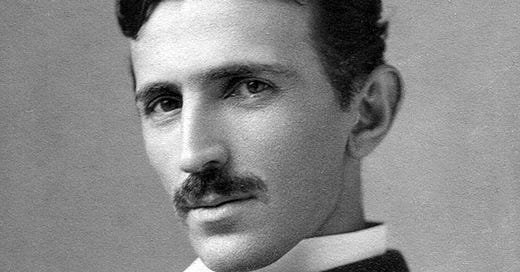I just came across a quote by Nicola Tesla in a post entitled Buddy James: The Sounds of Light by Robe Warrior at the electrogenesis substack.
I consider this extremely important. Light cannot be anything else but a longitudinal disturbance in the aether, involving alternate compressions and rarefactions. In other words, light can be nothing else than a sound wave in the aether.1
Then it struck me that I had just written about compression and rarefaction in my previous post, Galileo Galilei Supports Atomism, Part II:
The intuition of Galileo was of a fluid, with infinitely fine particles, where the infinitely fine voids allowed for rarefaction and compression.
Here is Galileo in the Two New Sciences:2
The compacting of infinitely many unquantifiable parts without interpenetration of quantified parts, and the previously explained expansion of infinitely many indivisibles with the interposition of indivisible voids, I believe to be the most that can be said to explain the condensation and rarefaction of bodies without the necessity of introducing interpenetration of bodies and [appealing to] quantified void spaces. If anything in it pleases you, make capital of that; if not, ignore this as idle, and my reasoning along with it, and go search for some other explanation that will bring you more peace of mind. I repeat only this: we are among infinites and indivisibles. [p.57]
I find it fascinating that Tesla in 1934 was using very similar words to what [condensazione e rarefazzione in the original Italian3] to what Galileo was using in 1638, almost three centuries earlier! For Tesla, Galileo’s atoms were the particles making up the aether.
If you wish to donate to support my work, please use the Buy Me a Coffee app.
Nikola Tesla (1856-1943). An Inventor's Seasoned Ideas. The New York Times, April 8th, 1934. https://www.nytimes.com/1934/04/08/archives/an-inventors-seasoned-ideas-nikola-tesla-pointing-to-grevious.html
Galileo Galilei. Two New Sciences, Including Centers of Gravity & Force of Percussion. Translated by Stillman Drake. University of Wisconsin Press, 1974.
Galileo Galilei. Le Opere. Vol VIII: Firenze: Tipografia de G. Barbera, 1898. p.96.





When you go out into the uncharted wastes of scientific history, you occasionally find familiar footprints. I think Tesla, like Velikovsky, found himself on a quest into the distant past to look for where we lost the path.
Thankyou for the mention John, I'm a great fan of your work!